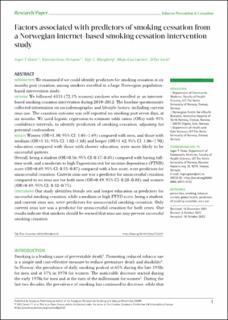| dc.contributor.author | Gram, Inger Torhild | |
| dc.contributor.author | Antypas, Konstantinos | |
| dc.contributor.author | Wangberg, Silje C | |
| dc.contributor.author | Løchen, Maja-Lisa | |
| dc.contributor.author | Larbi, Dillys | |
| dc.date.accessioned | 2023-03-01T15:34:19Z | |
| dc.date.available | 2023-03-01T15:34:19Z | |
| dc.date.created | 2022-12-02T08:34:48Z | |
| dc.date.issued | 2022 | |
| dc.identifier.citation | Tobacco Prevention & Cessation. 2022, 8 (October), 38. | en_US |
| dc.identifier.uri | https://hdl.handle.net/11250/3055105 | |
| dc.description.abstract | Introduction: We examined if we could identify predictors for smoking cessation at six months post cessation, among smokers enrolled in a large Norwegian populationbased intervention study.
Methods: We followed 4333 (72.1% women) smokers who enrolled in an internetbased smoking cessation intervention during 2010–2012. The baseline questionnaire collected information on sociodemographic and lifestyle factors, including current snus use. The cessation outcome was self-reported no smoking past seven days, at six months. We used logistic regression to estimate odds ratios (ORs) with 95% confidence intervals, to identify predictors of smoking cessation, adjusting for potential confounders.
Results: Women (OR=1.30; 95% CI: 1.01–1.69) compared with men, and those with medium (OR=1.31; 95% CI: 1.02–1.68) and longer (OR=1.42; 95% CI: 1.06–1.90) education compared with those with shorter education, were more likely to be successful quitters.
Overall, being a student (OR=0.56; 95% CI: 0.37–0.85) compared with having fulltime work, and a moderate to high Fagerström test for nicotine dependence (FTND) score (OR=0.69; 95% CI: 0.55–0.87) compared with a low score, were predictors for unsuccessful cessation. Current snus use was a predictor for unsuccessful cessation compared to no snus use for both men (OR=0.49; 95% CI: 0.28–0.88) and women (OR=0.49; 95% CI: 0.32–0.75).
Conclusions: Our study identifies female sex and longer education as predictors for successful smoking cessation, while a medium or high FTND score, being a student, and current snus use, were predictors for unsuccessful smoking cessation. Only current snus use was a predictor for unsuccessful cessation for both sexes. Our results indicate that smokers should be warned that snus use may prevent successful smoking cessation. | en_US |
| dc.language.iso | eng | en_US |
| dc.publisher | E.U European Publishing | en_US |
| dc.rights | Navngivelse 4.0 Internasjonal | * |
| dc.rights.uri | http://creativecommons.org/licenses/by/4.0/deed.no | * |
| dc.title | Factors associated with predictors of smoking cessation from a Norwegian internet-based smoking cessation intervention study | en_US |
| dc.title.alternative | Factors associated with predictors of smoking cessation from a Norwegian internet-based smoking cessation intervention study | en_US |
| dc.type | Peer reviewed | en_US |
| dc.type | Journal article | en_US |
| dc.description.version | publishedVersion | en_US |
| dc.rights.holder | © 2022 Gram I. T. et al. | en_US |
| dc.source.pagenumber | 0 | en_US |
| dc.source.volume | 8 | en_US |
| dc.source.journal | Tobacco Prevention & Cessation | en_US |
| dc.source.issue | October | en_US |
| dc.identifier.doi | 10.18332/tpc/155287 | |
| dc.identifier.cristin | 2087513 | |
| dc.source.articlenumber | 38 | en_US |
| cristin.ispublished | true | |
| cristin.fulltext | original | |
| cristin.qualitycode | 1 | |

